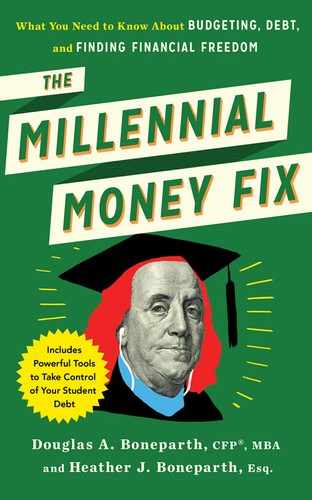NOTES
Chapter 1
1. The New York Life Center for Retirement Income at the American College of Financial Services, Press Release on the RICP Retirement Income Literacy Survey, “Crash course needed: four out of five Americans fail when quizzed on how to make their nest eggs last,” December 3, 2014, available online at: http://theamericancollege.edu/ricp-retirement-income-survey/press-release.php.
2. FINRA Investor Education Foundation, Financial Capability in the United States 2016, released July 2016, available online at: www.usfinancialcapability.org.
3. Council for Economic Education, Survey of the States, Economic and Personal Finance Education in Our Nation’s Schools 2016, availble online at: www.councilforeconed.org.
4. “A look at the shocking student loan debt statistic for 2017,” Student Loan Hero, available online at: https://studentloanhero.com/student-loan-debt-statistics.
5. See Project on Student Debt, reflecting numbers from 2004 through 2014, the Institute for College Access & Success, available online at: http://ticas.org/posd/map-state-data-2015.
6. See “The Student Loan Landscape,” Liberty Street Economics, The Federal Reserve Bank of New York, February 18, 2015, available online at: http://libertystreeteconomics.newyorkfed.org/2015/02/the_student_loan-landscape.html#.VoWGCJMrIWK.
7. Lend Edu, “Student Loan Debt Statistics 2017,” July 1, 2016, available online at: https://lendedu.com/blog/student-loan-debt-statistics.
8. Charles Lane, “How student loans help keep expensive schools in business,” Washington Post, August 26, 2015, available online at: https://washingtonpost.com/opinions/how-student-loans-help-keep-expensive-schools-in-business/2015/08/26/e7d7f83a-4c11-11e5-902f-39e9219e574b_story.html, citing Jason Delisle, “The Graduate Student Debt Review: The State of Graduate Student Borrowing,” New America Education Policy Program, March 2014, available online at: https://static.newamerica.org/attachments/750-the-graduate-student-debt-review/GradStudentDebtReview-Delisle-Final.pdf.
9. See Robert I. Lerman and Stefanie R. Schmidt, “An Overview of Economic, Social, and Demographic Trends Affecting the US Labor Market,” The Urban Institute, Washington, D.C., Final Report (August 1999), http://dol.gov.
10. See United States Census Bureau 1997, 2002, 2007 and 2012 Economic Census.
11. Numbers drawn from the American Society of News Editors’ annual newsroom diversity surveys, available online at: http://asne.org/newsroom_census.
12. For a lengthier discussion, read “A Less Gilded Future,” The Economist, May 5, 2011, available online at http://economist.com/node/18651114.
13. United States Census Bureau Press Release, “Millennials Outnumber Baby Boomers and Are Far More Diverse, Census Bureau Reports,” June 25, 2015, available online at: https://census.gov/newsroom/press-releases/2015/cb15-113.html. See also Pew Research Center, “Millennials overtake Baby Boomers as America’s largest generation,” April 25, 2016, available online at: http://pewresearch.org/fact-tank/2016/04/25/millennials-overtake-baby-boomers.
14. Boston Capital Group Perspectives, “How Millennials Are Changing the Face of Marketing Forever,” January 2014, available online at https://bcgperspectives.com/content/articles/marketing_center_consumer_customer_insight_how_millennials_changing_marketing_forever.
15. Ibid.
16. Housing contributes 15–18 percent of our gross domestic product. See https://nahb.org/en/research/housing-economics/housings-economic-impact/housings-contribution-to-gross-domestic-product-gdp.aspx.
Chapter 3
1. Pew Research Center, “The Rising Cost of Not Going to College,” released February 11, 2014, available online at: www.pewresearchcenter.org.
2. Georgetown University McCourt School of Public Policy, “The Economic Value of College Majors,” 2015, available online at: https://cew.georgetown.edu/cew-reports/valueofcollegemajors.
3. Average Public Undergrad Charges by Sector 2015–16, The College Board, available online at: https://trends.collegeboard.org/college-pricing/figures-tables/average-published-undergraduate-charges-sector-2016-17.
4. National Center for Education Statistics, Average graduate tuition and required fees in degree-granting postsecondary institutions…, 2014–2015, available online at https://nces.ed.gov/programs/digest/d15/tables/dt15_330.50.asp?current=yes.
5. Steve Odland, “College Costs Are Out Of Control,” Forbes, March 24, 2012, available online at http://forbes.com/sites/steveodland/2012/03/24/college-costs-are-soaring.
6. See Paul F. Campos, “The Reason College Tuition Costs So Much,” New York Times, April 4, 2015, available online at http://nytimes.com/2015/04/05/opinion/sunday/the-real-reason-college-tuition-costs-so-much.html?_r=0.
7. The National Center for Education Statistics, Table 303.25, Total fall enrollment in degree-granting postsecondary institutions, by control and level of institution: 1970 through 2014, prepared October 2015 and available online at: https://nces.ed.gov/programs/digest/d15/tables/dt15_303.25.asp?current=yes.
8. Jordan Friedman, “10 Universities with the Most Undergraduate Students,” U.S. News & World Report, September 22, 2016, available online at: http://usnews.com/education/best-colleges/the-short-list-college/articles/2016-09-22/10-universities-with-the-most-undergraduate-students.
9. President Barack Obama, “Remarks by the President on America’s College Promise,” The White House: Office of the Press Secretary, available online at: https://obamawhitehouse.archives.gov/the-press-office/2015/01/09/remarks-president-americas-college-promise.
10. Governor Andrew Cuomo, “Governor Cuomo Presents 1st Proposal of 2017 State of the State: Making College Tuition-Free for New York’s Middle Class Families,” available online at: https://governor.ny.gov/news/governor-cuomo-presents-1st-proposal-2017-state-state-making-college-tuition-free-new-york-s.
11. Learn more about the types of financial aid and how to apply on the U.S. Department of Education’s Website for Federal Student Aid, https://studentaid.ed.gov/sa.
12. One useful database of available scholarships is through Peterson’s, a Nelnet Company. See http://petersons.com.
Chapter 4
1. Visit the National Student Loan Data System, https://nslds.ed.gov/nslds/nslds_SA.
2. For a comprehensive overview and frequently asked questions about federal loan consolidation, visit https://studentaid.ed.gov/sa/repay-loans/consolidation.
Chapter 5
1. At the time of publication, The Patient Protection and Affordable Care Act, otherwise known as Obamacare, was still in effect. The authors recognize that the state of publicly available healthcare may be in transition in 2017 and beyond. Stay tuned with rest of us.
2. For a complete list of definitions, you can visit www.healthcare.gov/glossary.
3. The authors do indeed have a friend who broke his arm doing a New Year’s dance in New York City.
4. 457 plans rarely offer employer contributions.
Chapter 7
1. Mark Lino, Kevin Kuczynski, Nestor Rodriguez, and TusaRebecca Schap, “Expenditures on Children by Families, 2015,” United Stated Department of Agriculture, available online at: https://cnpp.usda.gov/sites/default/files/crc2015.pdf.
2. View Babycenter.com’s First-Year Baby Costs Calculator at http://babycenter.com/baby-cost-calculator.
3. View Babycenter.com’s Cost of Raising a Child Calculator at http://babycenter.com/cost-of-raising-child-calculator.
4. See Source for the 2015 Cost of Care Infographic available online at: https://care.com/c/stories/6811/sources-for-the-2015-cost-of-care-infographic.
